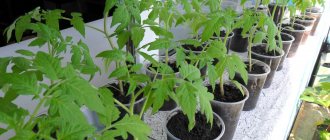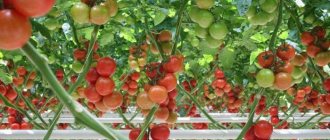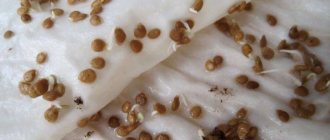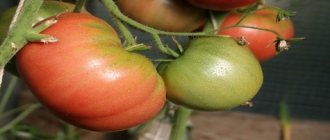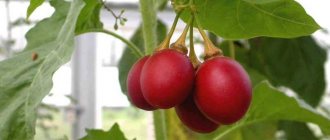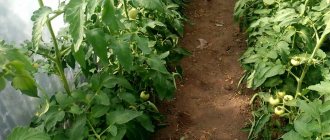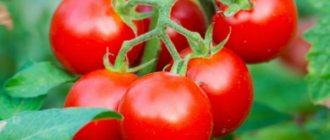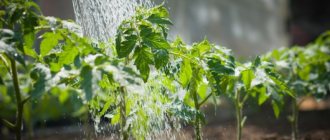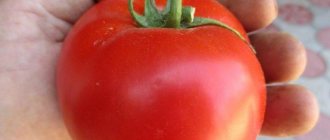The Paradise Delight tomato has been known to gardeners for decades. Despite the latest breeding achievements, it retains its leading position not only in summer cottages, but also in markets. Large fruits with excellent taste fully justify the name of tomato.
It is for its taste and ease of care that it is so loved by gardeners in all regions of our country. The crop is happily grown in small areas and on an industrial scale. The presentation of ripe vegetables is so attractive that it invites you to taste heavenly pleasure.
Characteristics and description of the variety
A culture with the unusual name Paradise Delight was bred by Transnistrian breeders in the 90s of the last century. In 1997, the variety was included in the State Register. Initially intended for open ground in the southern regions, but later it took root well in protected structures.
Distinctive features
Indeterminate bush, height 1.5-1.6 m, powerful stem, dense foliage, dark green leaves, simple inflorescences.
Mid-season species, 110-120 days pass from the moment of seedlings to full ripening.
Productivity depends on growing conditions and care, but as a rule, from 1 sq. m harvest up to 8 kg of fruit.
It is highly resistant to diseases such as cladosporiosis, tobacco mosaic, bacterial spot, but is susceptible to late blight.
Recommended for cultivation in open ground, although it adapts well to greenhouse conditions in regions with cold climates.
The culture requires obligatory staking of tall plants and regular pinching.
Fruit characteristics
The average weight is 400-450 g; if agronomic rules are followed, the fruits reach up to 700 g. The shape is round, slightly flattened, and the color is red. The taste is sweet, without sourness, the pulp is juicy, rich in vitamin C. There are 5-6 seed chambers, there are few seeds. The peel is dense, ribbed, and does not crack.
The species belongs to the salad variety; vegetables are ideal in salads, various appetizers, hot and vegetable dishes. Also used for preservation and processing of tomato products: juices, ketchups.
Ripe vegetables tolerate long-term storage and long-term transportation, which makes it possible to use the variety for commercial purposes.
The photo shows Paradise Delight tomatoes.
Growing rules
Tomato Paradise Pleasure is recommended to be grown in seedlings. It is impossible to collect seed stock from fruits, so it must be purchased annually.
Planting seedlings
The optimal time to start growing tomato varieties is the end of February or the first half of March.
Growing tomatoes requires preliminary preparation: it is recommended to buy seeds from trusted producers. The raw materials must be undamaged and dry. The seeds are treated with a solution of potassium permanganate or placed in Fitosporin for 10–12 hours.
Important! Some manufacturers process the raw materials themselves, so colored seeds do not need to be prepared for planting.
The tomato variety Paradise Pleasure is grown for seedlings using a certain type of soil. To do this, mix peat and sand in a 1:1 ratio. Enrich the finished mixture with 30 g of superphosphate and potassium sulfate.
The seeds are transferred to a cotton cloth and left in a solution of wood ash for 2–3, after which they are disinfected in Epin liquid for 24 hours. For the next 6 hours, the raw materials are kept in the refrigerator.
Containers (peat pots or containers with sections) are filled with soil and spilled with hot water. Using a stick, make depressions up to 3 cm in the soil and place seeds in them, which are sprinkled with earth on top.
The container is covered with film and transferred to a warm room with good lighting until sprouts appear. Next, the tomatoes are periodically taken outside for hardening in sunny weather for 10–15 minutes.
Caring for seedlings of this variety involves timely watering: the soil is treated with a spray bottle of warm water as it dries. When two true leaves appear, the seedlings are plucked if necessary: they are separated from a common container into peat pots so that the root system is strengthened and the tomato is not crowded.
Important! If it is necessary to grow a crop outside a greenhouse, it is recommended to use seedlings planted at the end of March: by the time they are transferred to the soil, they reach optimal size.
Tomato transplant
The period for transferring tomatoes to open ground is the end of April or the beginning of May, when the weather is sunny and the soil has warmed up. The crop is planted in the greenhouse when the soil has warmed up to +15 °C, and indoors at least +25 °C.
The open ground is dug up and organic fertilizers are applied 14 days before transplanting the tomatoes, after which the beds are formed. For 1 sq.m. It is recommended to plant no more than 2 plants according to the 70×60 scheme.
Dig a hole in the soil, then pour in a little water, transfer the tomato with a lump of earth into the hole and sprinkle it with soil. At the end of the work, it is recommended to cover the tomatoes of the Paradise Pleasure variety with compost and moisten them well.
Subsequent care for tomatoes
The basic principles of caring for Paradise Pleasure are no different from other varieties, but due to the high yield of the crop, additional fertilizing is required.
The first fertilizer is applied during planting or after 15–20 days. They use minerals as fertilizers or use specialized formulations for nightshade crops.
The Paradise Pleasure variety requires a mandatory garter, so it is recommended to use wooden pegs or metal structures to create support. The tomato is tied in several places so that it is in an upright position.
The stepsons under the first brush are removed, and after the appearance of the third brush, pinching is carried out from 3–4. When cultivating tomatoes for sale, it is recommended to save 4 Paradise Delight tomatoes for 2 and 3 clusters: they will all be large. Up to 6 fruits are left for personal needs; they grow smaller in size and weight.
It is necessary to moisten the soil 1–2 times a week; combine watering with fertilizing during fruit formation. It is recommended to use warm water and avoid getting liquid on the leaf plates. After moistening the soil, it is necessary to loosen the tomatoes, remove dried parts and damaged fruits.
How to grow seedlings
Sowing seeds for seedlings begins 55–60 days before planting in the ground. Before sowing, the seed needs careful preparation.
Seed preparation
First, the grains are inspected for visible damage. Seeds that are dark in color or have a curvature are discarded. The remaining ones are checked for emptiness by immersion in a saline solution. To do this, dissolve 1 teaspoon of salt in a glass of water. Those grains that float to the surface after 10 minutes are not suitable for planting. Then the seed material is disinfected by placing it in a weak solution of potassium permanganate. After 20 minutes, the grains are washed with running water.
To improve germination, the seeds are treated with growth stimulants, after which they are kept in the refrigerator on the bottom shelf for 5 hours. Such hardening further promotes rapid adaptation to outdoor conditions and strengthens the immune system.
Reference! The most used growth stimulants are Epin, Zircon, and Kornevin.
Before sowing, the seeds are germinated on damp gauze for 2-3 days at a temperature of +25 degrees. After germination of the sprouts, the grains are sown in the ground.
Container and soil
The soil is prepared from garden soil mixed with peat and river sand. 30 g of superphosphate and potassium sulfate are added to . To disinfect the soil, pour a hot solution of potassium permanganate or steam it in the oven for 15 minutes at a temperature of 50-60 degrees. The cooled soil is laid out in planting containers.
You can plant in a common wooden box and in separate containers, such as plastic cups, paper honeycombs, peat pots. When sowing into individual containers, further picking is not required. Small drainage holes are made at the bottom of the containers so that excess moisture does not stagnate when watering.
Sowing
The seeds are sown to a depth of 2 cm, sprinkled with the remaining soil on top, slightly moistened with warm, settled water using a spray bottle and left in a warm and bright room at a temperature of at least +23. The planting containers are covered with film for faster seed germination.
Reference! If the planting material is sown shallowly, it will germinate along with the shell, which will slow down the further growth of the seedlings.
Seedling care
After the sprouts appear, the containers are moved to a more illuminated place, but not in direct sunlight. There should be at least 13 hours of daylight. If there is a lack of natural light, add fluorescent lamps.
Further care of the seedlings consists of timely moderate watering. Water with warm, settled water along the edge of the nursery with a tablespoon. After watering, the soil is loosened superficially.
Reference! Loosening promotes better penetration of oxygen to young roots.
When 2 true leaves appear, the seedlings are picked and placed in separate containers. If the seedlings are left in a common box, the distance between the bushes is increased to 12-13 cm. When picking, non-viable plants are disposed of, leaving only strong, healthy bushes.
Reference! The picking procedure involves shortening the main spine by one third.
2 weeks before planting in the ground, seedlings begin to harden. To do this, it is taken outside in the daytime for 1 hour. Gradually this time is increased to 13 hours. Simultaneously with daytime hardening, the night temperature in the room is reduced to +14.
Heavenly pleasure in the garden
Like other productive tomato varieties for open ground, Paradise Delight requires proper planting and care. The soil for tomatoes is prepared in the fall, for which it is dug up and limed, or you can add organic matter. If you prepare the soil in the spring, then fertilizers are applied 2-3 weeks before planting so that it has time to absorb them.
As reviews from vegetable growers indicate about Paradise Delight tomatoes, it is better to plant them as seedlings, for which the seeds are sown in specially prepared containers at the end of March - beginning of April. Tomatoes are “southerners” that require a lot of sun and warmth. The best time to plant tomatoes in beds is May, when the ground has already warmed up enough so that the seedlings do not freeze at night.
- First of all, you need to prepare the holes, taking into account the fact that Paradise Delight requires a lot of space for full growth and development. Planting pattern – 70x60 cm, 2 bushes per 1 m2.
- Warm water should be poured into the holes and the seedlings should be planted without disturbing their earthen coma.
- Fill the holes and cover with compost to provide the plants with the necessary nutrients.
Important: when preparing holes, you need to bury pegs or make a trellis near each one in advance. Since this variety does not have height restrictions, you will have to slow down the bushes in growth by pinching them
How to grow tomatoes
After 2 months, the seedlings are ready for transplanting. But if the soil has not warmed up to 15 degrees by this time, planting seedlings in the ground should be postponed. Otherwise, the bushes will not begin to grow, therefore, fruiting will take several days.
Landing
The soil is prepared 2 weeks before transplanting the seedlings. The soil is dug up and humus is added. You can add organic fertilizers, such as bird droppings.
Planting pattern: 60 cm – distance between seedlings, 65 cm – between rows. For 1 sq. m place no more than 2 plants.
Transplanted in the evening, after sunset, into shallow holes. After planting, the bushes are sprinkled with compost and watered well. Upon completion of the work, the seedlings are left to adapt to new conditions for 8-10 days.
Further care for the tomato Paradise Delight
Regular watering is established no more than 2 times a week. On rainy days, the amount of watering is reduced, and on dry days, on the contrary, it is increased. But in any weather it is necessary to control the level of humidity in the beds: tomatoes do not like waterlogging.
Water with warm water, under the root, without getting on the leaves. After each watering, the soil is loosened and weeds with roots are removed. Weeds are carriers of infectious diseases and habitats for many insect pests.
Since the crop is high-yielding, it requires additional fertilizing. The first fertilizing is applied in the form of a full complex of mineral fertilizers 2 weeks after transplantation.
The second time they are fed with a mineral complex during flowering. During this period, you can replace minerals with organic matter, for example, mullein infusion in a ratio of 1:10.
Next, the crop is fed once every 2 weeks until fruiting begins. Fertilizers continue to be mineral fertilizers or organic matter. During fruiting, in addition to basic fertilizers, potassium substances are added to speed up fruit filling. During the ripening period, there is no need for frequent fertilizing, as well as frequent watering.
Features of care and possible difficulties
They are tied to wooden pegs or metal rods as the bushes grow and develop. The stem is fixed in several places at once so that the bushes do not bend and are always in an upright position. In the future, fruit-bearing branches are also tied to the installed support so that they do not break from the weight of ripe vegetables.
Under the first brush, all stepsons are removed, leaving stumps no more than 2 cm. After stepsoning, they are treated with a weak solution of potassium permanganate to avoid the development of infection. After the 4th fruiting cluster appears, the crown of the plant is pinched, thereby limiting its further growth.
Important. Form a plant with 1 or 2 stems. Under such conditions, the maximum yield is observed.
Diseases and pests
The tomato is immune to tobacco mosaic virus, bacterial spot and cladosporiosis. But without preventive measures, the risk of late blight is high.
Late blight is a fungal disease that develops at high humidity. Moderate watering is one of the main measures taken to eliminate the cause of the disease. Prevention also includes systematic loosening, removal of weeds with roots and regular ventilation of closed structures if tomatoes are planted in a greenhouse.
Attention! “Fitosporin” or copper sulfate, which is used to treat the soil and diseased plants, helps in the fight against late blight.
To destroy insect pests, chemical and traditional methods are used. But remember that the use of insecticides is possible only before the first ovaries appear.
As folk remedies, strong decoctions of onion peels and garlic are used, which are sprayed onto entire plants. Such decoctions repel flying insects from the beds. Mulching beds with straw protects the root system from pests. Planting sharp-smelling plants next to tomatoes repels slugs and the Colorado potato beetle from the beds.
Features of agricultural technology
The tomato, according to breeding research, is fully adapted to any changes in weather conditions, but there are still some recommendations for care:
If the bushes are grown in open ground, it is imperative to provide reliable support. Standard structures made of stretched ropes or simply individual pegs driven in next to each bush will do. You can also protect the brushes, especially when growing outdoors. The hybrid is resistant to almost all common diseases, but prevention is recommended. You can treat with ready-made solutions or limit yourself to folk recipes, for example, spray with milk. It is recommended to start fertilizing plants with solutions of phosphorus or potassium compounds
Read a detailed article on how to feed tomatoes. Unprotected cultivation requires pinching of the crown
Since most gardeners use greenhouses for early tomatoes, it is important to note the need for regular ventilation. Tomatoes do not crack, but it is necessary to ensure air circulation in order to prevent the emergence and development of infectious diseases
The Pleasure tomato is new for 2021 and is slowly conquering more and more garden plots. Summer residents are captivated by the easy care and rapid ripening of tomatoes.
Nuances for open ground and greenhouse conditions
Greenhouse plants are much taller than their outdoor brothers. They need to limit their growth by pinching the top of their head. If growth is not stopped, beneficial substances will be spent on unnecessary branches.
The highest rates of fruiting were noted in the southern regions. In areas with a cold climate, the crop not only grows and develops more slowly than in the south, but the quantitative indicator is also significantly reduced. However, there are many who want to grow this particular type of tomato in the northern regions. The crop, planted in well-heated closed structures, adapts to greenhouse conditions and produces sufficient offspring.
When growing tomatoes for sale, 4 tomatoes are left on the fruiting branches. This technique promotes the formation of larger vegetables. When all formed tomatoes are left on the bunch, they grow smaller in size and weight.
Picking seedlings
Planting of seedlings is carried out a month later, after sowing the grains in the ground. With proper cultivation and care, by this time two true leaves should already appear on the plants.
- The seedling is cut at soil level.
- The cut sprout is placed in a plastic cup with warm water for 20 minutes.
- The seedlings are planted in the soil and covered with a film cap.
- After 2 days, the plants are placed in a bright room and the hardening stage begins.
Important! It is better to plant plants in peat soil or specialized soil. It is strictly not recommended to add humus to the soil, as it will contribute to the development of root rot.
. The root system of seedlings is trimmed to prevent the risk of infection transfer from one container to another
Thanks to this technique, plants get sick less and grow as healthy as possible.
The root system of seedlings is pruned in order to prevent the risk of transferring infection from one container to another. Thanks to this technique, plants get sick less and grow as healthy as possible.
Harvesting and application
Vegetables begin to ripen in July. The tomatoes are quite large and are ideal for fresh consumption. The variety belongs to the salad variety, so tomatoes retain excellent taste in summer salads, in hot and vegetable dishes, as a varied snack, and in baked meats. They make excellent freshly squeezed juice.
Ripe vegetables are also used for canning, marinades and pickling. But due to their large size, it will not be possible to prepare whole vegetables for the winter. Tomato is used for processing into tomato products, for example: adjika, juice, paste, ketchup.
Ripe vegetables are subject to long-term storage and can withstand long-term transportation without loss of presentation and taste. For this reason, entrepreneurs use the species for commercial purposes.
Advantages and disadvantages
The positive qualities of tomato include:
- good adaptation to weather conditions;
- high resistance to diseases;
- high fruiting rate;
- simple agricultural technology;
- possibility of breeding for sale;
- excellent taste of fruits;
- large vegetables;
- excellent presentation;
- long storage;
- versatility in cooking;
The negative aspects include the need for mandatory gartering and pinching of plants. But these shortcomings can be called conditional, since they do not require much time and effort.
Farmer reviews
The review will introduce you to the opinions of gardeners who grow tomato crops on their plots. Opinions about tomato are only positive, from which we can draw a conclusion about the reliability of the crop.
Olga, Voronezh: “I’ve been growing this variety for several years now and I’m not going to give it up. For me, to be honest, there is nothing tastier than a tomato. A big plus is immunity to cladosporiosis, which affects many tomatoes. The stem is tall and powerful, I tie up the bushes and the stepson. With proper care, the fruits reach up to 500 g.”
Vladimir, Bryansk: “The fruits ripen are really very tasty, top five, large in size, fleshy. I plant the tomato in a greenhouse, at a great distance from each other. The stems are powerful, the leaves are large. In the spaces between the bushes I will plant basil or some other herb. I lead the tomato into one main stem. There is enough harvest to eat and make juice for the winter.”
Planting Paradise Delight in a greenhouse
There is an opinion that greenhouse plants are weak, and their fruits are tasteless and cannot be compared with vegetables from garden beds. Maybe this was the case before, but modern hybrid universal varieties, adapted for growing both under glass and in the open air, differ little in their qualities.
The same can be said about the Paradise Delight tomato, the characteristics of which are practically the same and do not depend on where exactly it was planted.
To grow tomatoes in a greenhouse, you need to follow simple rules:
Work begins with preparing the seeds. They should be treated with a weak solution of potassium permanganate or Fitosporin, placing them in it for 10-12 hours. By sowing them in seedling boxes, within a week you can expect strong sprouts with several leaves, ready to sprout.
Important: if the seeds in a package from an agricultural company look like they have been painted, it means that the manufacturer has already carried out the processing and they do not need additional procedures. The next stage is preparing the soil in the greenhouse
It should be sufficiently fertilized, but without fanaticism. Some beginners believe that the more fertilizer, the higher the yield. This is fundamentally wrong. All they will get is lush greenery with small and few fruits. Tomatoes like, for example, this composition:
The next stage is preparing the soil in the greenhouse. It should be sufficiently fertilized, but without fanaticism. Some beginners believe that the more fertilizer, the higher the yield. This is fundamentally wrong. All they will get is lush greenery with small and few fruits. Tomatoes like, for example, this composition:
- one part of the land
- 1 part peat
- 1 part sand.
This mixture should be enriched with a solution of 30 g of potassium sulfate with superphosphate and 10 g of Urea per 10 liters of water.
The best time to plant tomatoes. Paradise pleasure in a greenhouse is the end of April, the beginning of May, when the earth has already warmed up sufficiently. The air temperature in the room should be at least +25, and the soil temperature – +15 degrees.
Important: since this variety is quite tall, seedlings should be planted in a checkerboard pattern, but no more than two bushes per m2
